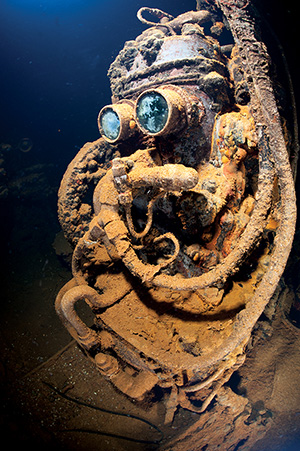The Ticking Time Bomb of War WrecksContents of this Issue: Two Fish Divers, Lembongan; Alam Batu, Bali, Indonesia An Investment for the Gullible When Dive Gear Evidence Goes Missing Belize, Little Cayman, the Conflict Islands American Underwater Photography Team Cleans Up Again When Your Cabin Mate Gets Sick The Conception had been Exempted from USCG Fire Safety Standards The Ticking Time Bomb of War Wrecks The Best Travelerís Diarrhea Drug A Template for Liveaboard Safety Precautions The Ins and Outs of Trip Insurance Lawsuit over Crown-of-Thorns Starfish Sting A Chance to Get Shark Bytes at Half Price Diving and Politeness: Be Patient and Take Your Place in Line Editorial Office: Ben Davison Publisher and Editor Undercurrent 3020 Bridgeway, Suite 102 Sausalito, CA 94965 from the February, 2020 issue of Undercurrent
The wrecks of Truk Lagoon and Bikini Atoll, the SS Thistlegorm and SS Rosalie Moller in the Red Sea, the Liberty in Bali, the wrecks of Coron Bay in the Philippines, the Iro in Palau, the Toa Maru near Gizo in the Solomon Islands, the WWI German fleet in Scotland's Scapa Flow; these are some of the wrecks that we dive or would love to dive.
Most of the passionate divers who come to explore these underwater playgrounds -- packed with colorful corals, sponges, tropical fish and even sharks and rays -- have little idea of the threat looming behind these beautiful ecosystems. A major leak of oil could destroy it all. More than 3,000 ships were sunk in the Pacific War, and 300 of those were loaded oil tankers. And they are quietly rusting away. Matt Carter, a marine archaeologist, has been working alongside partners from the University of Newcastle, Australia, and the Secretariat of the Pacific Regional Environment. He has recently returned from Truk Lagoon, where he says, of the 65 shipwrecks sunk by American action in 1944, 17 are on a list of highest risk potentially polluting wrecks. Marine corrosion expert Dr. Ian MacLeod reckons the deteriorating wrecks would enter a peak-leak period around just about now. The threat is significant. In 2001, a state of emergency was declared at Yap when the oil tanker, the USS Mississinewa, started leaking oil. The U.S. Navy removed 6,000 tons of oil in a major salvage operation. The Shinkoku Maru in Truk is believed to hold significant amounts of oil. In October 2018, the U.S. Navy recovered 230,000 gallons of oil from the German cruiser Prinz Eugen, capsized at Kwajalein. In July 2019, the U.S. Coast Guard retrieved 450,000 gallons of oil from the Coimbra shipwreck. Exhaled air from divers, pooling in cavities within the wrecks, increases the rate of rust and corrosion. The increasing incidence of typhoons and severe storms is speeding up the degradation and of the wrecks too. So for us divers, it's a matter of visiting these spectacular wrecks while they are still worth diving. The issue of the leaking oil polluting the marine eco-system might mean that local authorities might even decide to hasten their demise before the nearby reefs are destroyed. It's unlikely that anyone would go to the expense of recovering the oil unless it affects a tourist beach. |

I want to get all the stories! Tell me how I can become an Undercurrent Online Member and get online access to all the articles of Undercurrent as well as thousands of first hand reports on dive operations world-wide
| Home | Online Members Area | My Account |
Login
|
Join
|
| Travel Index |
Dive Resort & Liveaboard Reviews
|
Featured Reports
|
Recent
Issues
|
Back Issues
|
|
Dive Gear
Index
|
Health/Safety Index
|
Environment & Misc.
Index
|
Seasonal Planner
|
Blogs
|
Free Articles
|
Book Picks
|
News
|
|
Special Offers
|
RSS
|
FAQ
|
About Us
|
Contact Us
|
Links
|
3020 Bridgeway, Ste 102, Sausalito, Ca 94965
All rights reserved.

 They make interesting time capsules and fabulous habitats for marine life, but they also contain thousands of gallons of oil and petrochemicals that are potentially going to wipe out all that life too. So says Matt Carter, Research Director at the conservation charity Major Projects Foundation.
They make interesting time capsules and fabulous habitats for marine life, but they also contain thousands of gallons of oil and petrochemicals that are potentially going to wipe out all that life too. So says Matt Carter, Research Director at the conservation charity Major Projects Foundation.